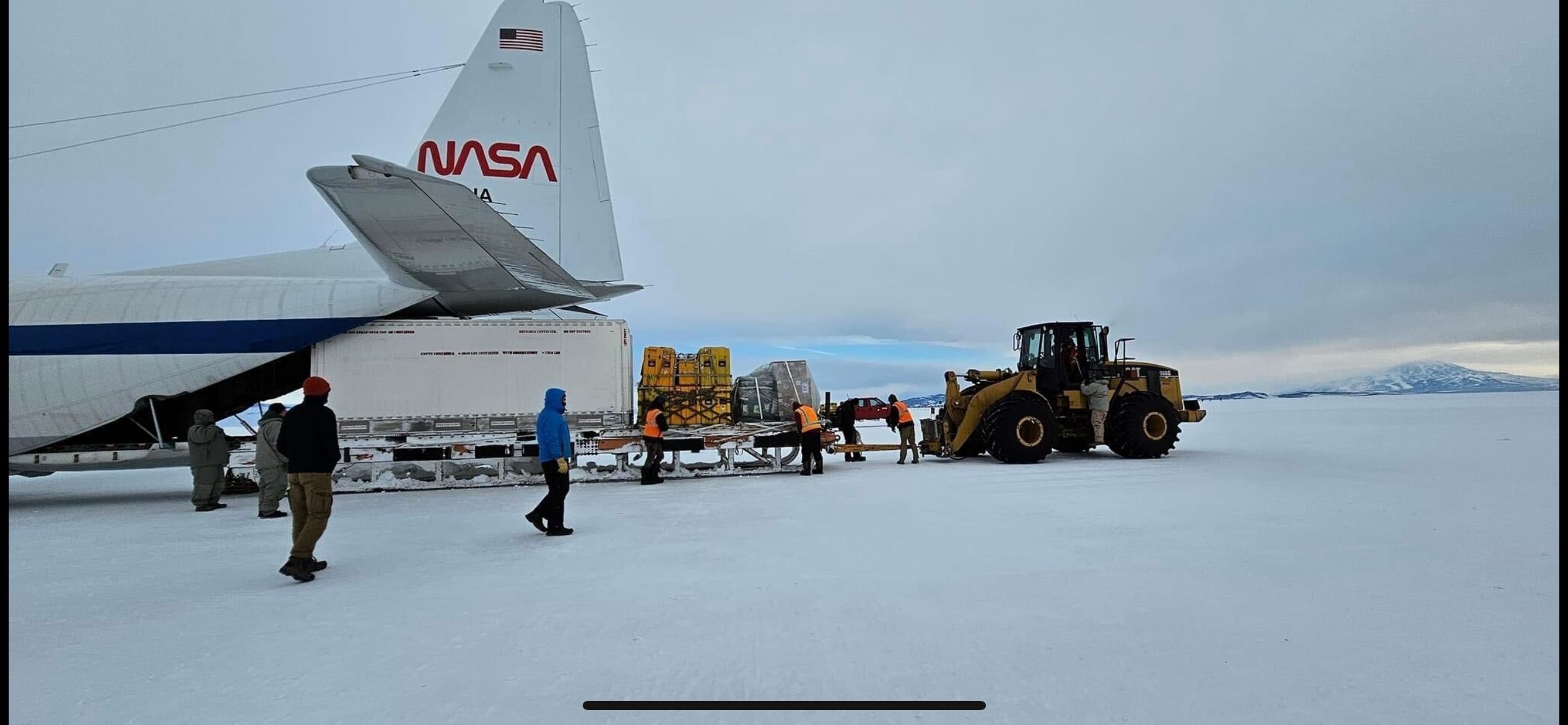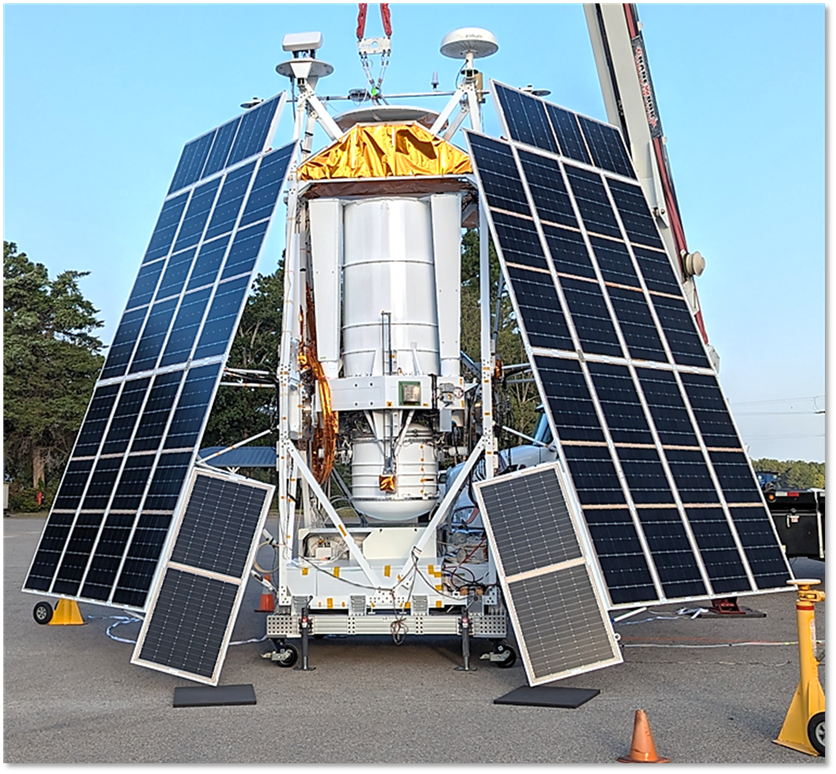Na een lange reis met veel tussenstops is ballontelescoop Gusto op per vliegtuig aangekomen op Antarctica. De lancering staat gepland voor 15 december 2023. Gusto is uitgerust met drie 8-pixel ver-infrarood camera’s, geleverd door SRON en TU Delft. De telescoop gaat de eerste grote-schaal survey uitvoeren van drie elementen binnen stofwolken tussen de sterren, inclusief hun snelheid.

NASA’s Galactic/Extragalactic ULDB Spectroscopic Terahertz Observatory (GUSTO) is een ballonobservatorium dat 55 dagen door de atmosfeer zal zweven op 36 kilometer hoogte boven Antarctica. Gusto wordt gedragen door een Ultra-Long Duration heliumballon, ter grootte van een voetbalveld, en bestaat uit een telescoop van één meter in diameter en een cryogeen instrument met supergeleidende detectoren die werken bij -269 °C. Het observatorium heeft drie camera’s voor ver-infraroodstraling van 1,4 en 1,9 en 4,7 teraHertz om emissielijnen te detecteren van respectievelijk geïoniseerd stikstof (NI), koolstof (CII) en zuurstof (OI) in het interstellaire medium (ISM)—het gas en stof tussen de sterren.
Voordat hij op Antarctica arriveerde, heeft Gusto een lange reis afgelegd. De detector-arrays zijn eerst van Groningen (SRON) naar Tucson (University of Arizona) gevlogen. De telescoop met het cryogene instrument is per vrachtwagen van Tucson naar Maryland (Johns Hopkins) gereden. Na integratie met een gondola is hij vervolgens naar Texas (CSBF) vervoerd, opnieuw per vrachtwagen. Vanwege de grote afstand tussen Texas en McMurdo op Antarctica heeft het zogenoemde Wallops C130-vliegtuig een aantal tussenstops moeten maken op weg naar Gusto’s eindbestemming.
Volgens planning stijgt Gusto op 15 december op vanaf Williams Field. Maar de exacte datum hangt af van wanneer de circumpolaire vortex in de stratosfeer boven Antarctica is gevormd en van de lokale weersomstandigheden. Gusto vliegt met de vortex mee in een cirkelbeweging op 36 kilometer hoogte. Normaal gesproken duurt dit langer dan 55 dagen, maar als de vortex aan kracht inboet zal Gusto naar buiten spiraleren en daalt de observatie-efficiëntie omdat Gusto soms in het donker terechtkomt. De zonnepanelen krijgen minder zonlicht en bovendien ontstaat er een temperatuurverschil tussen dag en nacht. Uiteindelijk belandt het observatorium in zee of op Australië.
De Gusto-missie wordt geleid door de University of Arizona. SRON en TU Delft hebben de zogenoemde Hot Electron Bolometer multi-pixel (heterodyne) camera’s geleverd en een faserooster om een multi-beam lokale oscillator te creëren uit een enkele 4,7 THz quantum cascase laser. De lokale oscillator helpt de detectoren om de exacte kleur te bepalen van het inkomende ver-infrarode licht. Bovendien reist Jose Silva (SRON) namens het Nederlandse Gusto-team naar Antarctica om bij te dragen aan de vluchtcampagne.
Volg Jose Silva’s reis via de SRON social mediakanalen: Twitter, Facebook en LinkedIn.

NASA’s GUSTO balloon observatory has arrived on Antarctica onboard the Wallops C-130 airplane. It is scheduled for launch around the 15th of December. GUSTO is equipped with three 8-pixel far-infrared cameras delivered by SRON and TU Delft and will carry out the first large-scale survey with velocity-resolved imaging of the spectral lines emitted by three cosmic elements between stars.

NASA’s Galactic/Extragalactic ULDB Spectroscopic Terahertz Observatory (GUSTO) is a balloon observatory that will drift and circulate in the Earth’s atmosphere at 36 km altitude above Antarctica for 55 days. The observatory is carried by an Ultra-Long Duration helium balloonwith the size of a football field and consists of a telescope one meter in diameter and a cryogenic instrument with superconducting detectors operating at -269 °C. GUSTO carries three array receivers for far-infrared radiation of 1.4, 1.9, and 4.7 terahertz to detect and map emission lines of respectively ionized nitrogen [NI], carbon [CII], and oxygen [OI] in the interstellar medium (ISM)—the gas and dust in between stars.
Before arriving on Antarctica, GUSTO has gone through a long journey. The detector arrays were first air shipped from Groningen (SRON) to Tucson (University of Arizona). The telescope with the cryogenic instrument was transported from Tucson to Maryland (Johns Hopkins Applied Physics Laboratory) by a truck. GUSTO’s payload integrated with a gondola was then further moved to Texas (CSBF), again by a truck. Due to a distance of 16100 kilometers from Texas to McMurdo located at Ross Island, Antarctica, the C130 airplane has made a few stops on its way to GUSTO’s final destination.
GUSTO will lift off from Williams Field, Antarctica, on the 15th of December as the baseline launch date. However, the exact date will depend on when the stratospheric, circumpolar vortex above Antarctica is formed and on the weather conditions at the launch site. The vortex allows GUSTO to float circularly at an altitude of 36 km. Normally speaking it will last longer than 55 days. However, once the vortex breaks down, GUSTO will spiral outwards, and the observation efficiency will decrease slowly because of an increased temperature difference between day and night and a reduced electrical power from the solar panels. Eventually, GUSTO will be terminated and likely drop into the ocean or in Australia. It is not going to be salvaged by NASA because GUSTO is the first balloon observatory in history to be managed as a space mission.
GUSTO is led by the University of Arizona. SRON and TU Delft (Faculty of Applied Physics) delivered the so-called Hot Electron Bolometer multi-pixel (heterodyne) cameras and a novel phase grating for creating a multi-beam local oscillator originated from a single 4.7 THz quantum cascade laser. The local oscillator helps the detectors to determine the exact color of the incoming far-infrared light. Furthermore, Jose Silva on behalf of the Dutch GUSTO team will fly down to McMurdo, and contribute the GUSTO’s Antarctica flight campaign.
Follow Jose Silva’s journey through the SRON social media channels: Twitter, Facebook and LinkedIn.



